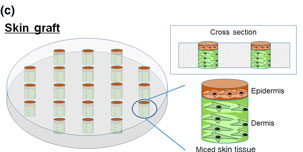Crossref Citations
This article has been cited by the following publications. This list is generated based on data provided by
Crossref.
Gionet-Gonzales, Marissa A
and
Leach, J Kent
2018.
Engineering principles for guiding spheroid function in the regeneration of bone, cartilage, and skin.
Biomedical Materials,
Vol. 13,
Issue. 3,
p.
034109.
Chen, Shixuan
Li, Ruiquan
Li, Xiaoran
and
Xie, Jingwei
2018.
Electrospinning: An enabling nanotechnology platform for drug delivery and regenerative medicine.
Advanced Drug Delivery Reviews,
Vol. 132,
Issue. ,
p.
188.
Yun, Ye Eun
Jung, Youn Jae
Choi, Yeo Jin
Choi, Ji Suk
and
Cho, Yong Woo
2018.
Artificial skin models for animal-free testing.
Journal of Pharmaceutical Investigation,
Vol. 48,
Issue. 2,
p.
215.
Jiang, Jiang
Chen, Shixuan
Wang, Hongjun
Carlson, Mark A.
Gombart, Adrian F.
and
Xie, Jingwei
2018.
CO2-expanded nanofiber scaffolds maintain activity of encapsulated bioactive materials and promote cellular infiltration and positive host response.
Acta Biomaterialia,
Vol. 68,
Issue. ,
p.
237.
Maciel, Jeanny S.
Azevedo, Sara
Correia, Clara R.
Costa, Ana M. S.
Costa, Rui R.
Magalhães, Francisco A.
de Sousa Monteiro, Aliny Abreu
Costa, José Francisco Gomes
de Paula, Regina C. M
Feitosa, Judith P. A.
and
Mano, João F.
2019.
Oxidized Cashew Gum Scaffolds for Tissue Engineering.
Macromolecular Materials and Engineering,
Vol. 304,
Issue. 3,
Bal-Öztürk, Ayça
Miccoli, Beatrice
Avci-Adali, Meltem
Mogtader, Ferzaneh
Sharifi, Fatemeh
Çeçen, Berivan
Yaşayan, Gökçen
Braeken, Dries
and
Alarcin, Emine
2019.
Current Strategies and Future Perspectives of Skin-on-a-Chip Platforms: Innovations, Technical Challenges and Commercial Outlook.
Current Pharmaceutical Design,
Vol. 24,
Issue. 45,
p.
5437.
Tullii, Gabriele
Giona, Federica
Lodola, Francesco
Bonfadini, Silvio
Bossio, Caterina
Varo, Simone
Desii, Andrea
Criante, Luigino
Sala, Carlo
Pasini, Mariacecilia
Verpelli, Chiara
Galeotti, Francesco
and
Antognazza, Maria Rosa
2019.
High-Aspect-Ratio Semiconducting Polymer Pillars for 3D Cell Cultures.
ACS Applied Materials & Interfaces,
Vol. 11,
Issue. 31,
p.
28125.
Rajpoot, Kuldeep
Safavi, Maliheh
Sreeharsha, Nagaraja
and
Tekade, Rakesh K.
2020.
The Future of Pharmaceutical Product Development and Research.
p.
367.
Bongiovanni Abel, Silvestre
Montini Ballarin, Florencia
and
Abraham, Gustavo A
2020.
Combination of electrospinning with other techniques for the fabrication of 3D polymeric and composite nanofibrous scaffolds with improved cellular interactions.
Nanotechnology,
Vol. 31,
Issue. 17,
p.
172002.
Chen, Shixuan
John, Johnson V.
McCarthy, Alec
and
Xie, Jingwei
2020.
New forms of electrospun nanofiber materials for biomedical applications.
Journal of Materials Chemistry B,
Vol. 8,
Issue. 17,
p.
3733.
Milos, Frano
Tullii, Gabriele
Gobbo, Federico
Lodola, Francesco
Galeotti, Francesco
Verpelli, Chiara
Mayer, Dirk
Maybeck, Vanessa
Offenhäusser, Andreas
and
Antognazza, Maria Rosa
2021.
High Aspect Ratio and Light-Sensitive Micropillars Based on a Semiconducting Polymer Optically Regulate Neuronal Growth.
ACS Applied Materials & Interfaces,
Vol. 13,
Issue. 20,
p.
23438.
Nokoorani, Yeganeh Dorri
Shamloo, Amir
Bahadoran, Maedeh
and
Moravvej, Hamideh
2021.
Fabrication and characterization of scaffolds containing different amounts of allantoin for skin tissue engineering.
Scientific Reports,
Vol. 11,
Issue. 1,
Bolívar-Monsalve, Edna Johana
Alvarez, Mario Moisés
Hosseini, Samira
Espinosa-Hernandez, Michelle Alejandra
Ceballos-González, Carlos Fernando
Sanchez-Dominguez, Margarita
Shin, Su Ryon
Cecen, Berivan
Hassan, Shabir
Di Maio, Ernesto
and
Trujillo-de Santiago, Grissel
2021.
Engineering bioactive synthetic polymers for biomedical applications: a review with emphasis on tissue engineering and controlled release.
Materials Advances,
Vol. 2,
Issue. 14,
p.
4447.
Han, Shanshan
Nie, Kexin
Li, Jingchao
Sun, Qingqing
Wang, Xiaofeng
Li, Xiaomeng
Li, Qian
and
Wang, Juan
2021.
3D Electrospun Nanofiber-Based Scaffolds: From Preparations and Properties to Tissue Regeneration Applications.
Stem Cells International,
Vol. 2021,
Issue. ,
p.
1.
Erickson, Ariane
Chiarelli, Peter A.
Huang, Jianxi
Levengood, Sheeny Lan
and
Zhang, Miqin
2022.
Electrospun nanofibers for 3-D cancer models, diagnostics, and therapy.
Nanoscale Horizons,
Vol. 7,
Issue. 11,
p.
1279.
John, Johnson V.
McCarthy, Alec
and
Xie, Jingwei
2022.
Tissue Engineering.
p.
175.
John, Johnson V.
McCarthy, Alec
Karan, Anik
and
Xie, Jingwei
2022.
Electrospun Nanofibers for Wound Management.
ChemNanoMat,
Vol. 8,
Issue. 7,
Giorno, Luciana Pastena
Rodrigues, Leonardo Ribeiro
and
Santos, Arnaldo Rodrigues
2022.
Characterization and in vitro analysis of a poly(ε-caprolactone)–gelatin matrix produced by rotary jet spinning and applied as a skin dressing.
Polymer Bulletin,
Vol. 79,
Issue. 10,
p.
9131.
Chaturvedi, Deepa
Mukherjee, Sourav
Sawant, Pooja
Jain, Prajakta Dandekar
and
Majumder, Abhijit
2022.
Microfluidics and Multi Organs on Chip.
p.
495.
Mirhaj, Marjan
Labbaf, Sheyda
Tavakoli, Mohamadreza
and
Seifalian, Amelia
2022.
An Overview on the Recent Advances in the Treatment of Infected Wounds: Antibacterial Wound Dressings.
Macromolecular Bioscience,
Vol. 22,
Issue. 7,





